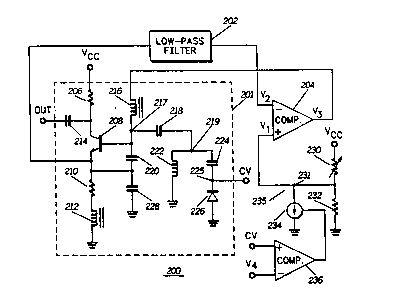Une partie des informations de ce site Web a été fournie par des sources externes. Le gouvernement du Canada n'assume aucune responsabilité concernant la précision, l'actualité ou la fiabilité des informations fournies par les sources externes. Les utilisateurs qui désirent employer cette information devraient consulter directement la source des informations. Le contenu fourni par les sources externes n'est pas assujetti aux exigences sur les langues officielles, la protection des renseignements personnels et l'accessibilité.
L'apparition de différences dans le texte et l'image des Revendications et de l'Abrégé dépend du moment auquel le document est publié. Les textes des Revendications et de l'Abrégé sont affichés :
| (12) Brevet: | (11) CA 2063404 |
|---|---|
| (54) Titre français: | OSCILLATEUR A COMMANDE AUTOMATIQUE PAR TENSION |
| (54) Titre anglais: | VOLTAGE CONTROL OSCILLATOR WITH AUTOMATIC CURRENT CONTROL |
| Statut: | Périmé et au-delà du délai pour l’annulation |
| (51) Classification internationale des brevets (CIB): |
|
|---|---|
| (72) Inventeurs : |
|
| (73) Titulaires : |
|
| (71) Demandeurs : |
|
| (74) Agent: | GOWLING WLG (CANADA) LLP |
| (74) Co-agent: | |
| (45) Délivré: | 1993-09-21 |
| (86) Date de dépôt PCT: | 1990-05-17 |
| (87) Mise à la disponibilité du public: | 1990-12-03 |
| Requête d'examen: | 1991-10-29 |
| Licence disponible: | S.O. |
| Cédé au domaine public: | S.O. |
| (25) Langue des documents déposés: | Anglais |
| Traité de coopération en matière de brevets (PCT): | Oui |
|---|---|
| (86) Numéro de la demande PCT: | PCT/US1990/002678 |
| (87) Numéro de publication internationale PCT: | US1990002678 |
| (85) Entrée nationale: | 1991-10-29 |
| (30) Données de priorité de la demande: | ||||||
|---|---|---|---|---|---|---|
|
2063404 9015484 PCTABS00002
An automatic voltage-controlled oscillator (VCO) current control
circuit (100, 200, 300 or 400) that senses a voltage in the VCO
(201) representative of the current of the VCO (201), compares
that voltage (V2) to a reference voltage (V1), and applies the
voltage (V3) resulting from that comparison back to the VCO (201) at a
point therein that changes its bias state in such a manner as to
maintain the noise level in the VCO at a minimum and also
maintains the power output of the oscillator substantially constant.
Note : Les revendications sont présentées dans la langue officielle dans laquelle elles ont été soumises.
Note : Les descriptions sont présentées dans la langue officielle dans laquelle elles ont été soumises.

2024-08-01 : Dans le cadre de la transition vers les Brevets de nouvelle génération (BNG), la base de données sur les brevets canadiens (BDBC) contient désormais un Historique d'événement plus détaillé, qui reproduit le Journal des événements de notre nouvelle solution interne.
Veuillez noter que les événements débutant par « Inactive : » se réfèrent à des événements qui ne sont plus utilisés dans notre nouvelle solution interne.
Pour une meilleure compréhension de l'état de la demande ou brevet qui figure sur cette page, la rubrique Mise en garde , et les descriptions de Brevet , Historique d'événement , Taxes périodiques et Historique des paiements devraient être consultées.
| Description | Date |
|---|---|
| Inactive : CIB de MCD | 2006-03-11 |
| Inactive : CIB de MCD | 2006-03-11 |
| Inactive : CIB de MCD | 2006-03-11 |
| Le délai pour l'annulation est expiré | 2002-05-17 |
| Lettre envoyée | 2001-05-17 |
| Accordé par délivrance | 1993-09-21 |
| Exigences pour une requête d'examen - jugée conforme | 1991-10-29 |
| Toutes les exigences pour l'examen - jugée conforme | 1991-10-29 |
| Demande publiée (accessible au public) | 1990-12-03 |
Il n'y a pas d'historique d'abandonnement
| Type de taxes | Anniversaire | Échéance | Date payée |
|---|---|---|---|
| TM (brevet, 8e anniv.) - générale | 1998-05-19 | 1998-04-06 | |
| TM (brevet, 9e anniv.) - générale | 1999-05-17 | 1999-04-06 | |
| TM (brevet, 10e anniv.) - générale | 2000-05-17 | 2000-04-04 |
Les titulaires actuels et antérieures au dossier sont affichés en ordre alphabétique.
| Titulaires actuels au dossier |
|---|
| MOTOROLA, INC. |
| Titulaires antérieures au dossier |
|---|
| WALTER H., JR. KEHLER |